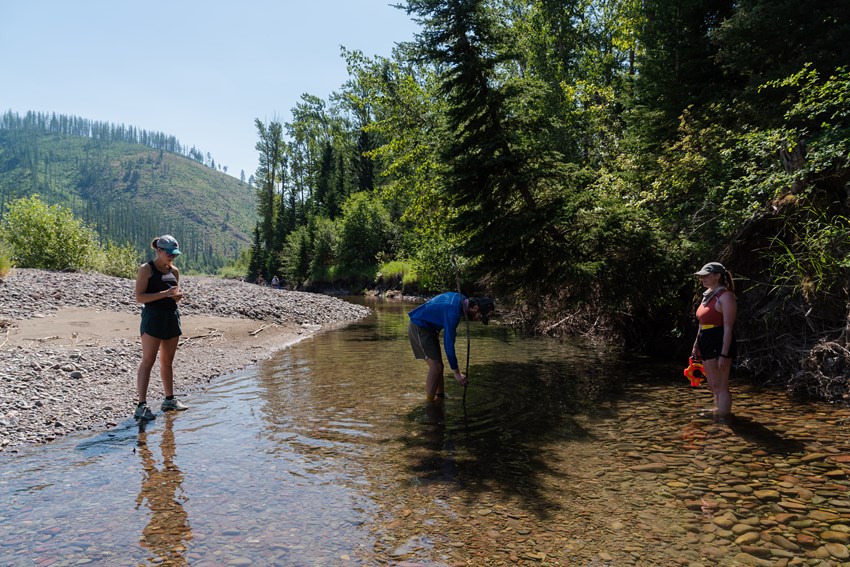UM Bio Station Researchers Help Track Pulse of our Nation’s Rivers and Streams
Rivers and streams are like the arteries and blood vessels in a human body, and so monitoring the metabolic respiration and production rates of earth’s freshwaters can be an excellent way to better understand the overall health of our planet. To accomplish this task, scientists monitor fluctuations in oxygen and carbon that occur in streams, as gases are absorbed and released by organisms like microbes, algae, insects, and fish as they go about their basic life functions.
In the past in order to study stream metabolism, scientists had to rely on snapshot data composed of measurements taken from a small number of streams over a few hours or days. Now, by using years of data combined with new computational and statistical methods, a research team pioneered an approach to covert water quality and environmental data into estimates of photosynthesis and respiration for specific rivers and river types.
Current and former University of Montana Flathead Lake Biological Station (FLBS) researchers Maite Arroita, Joanna Blaszczak, Alice Carter, and Lauren Koenig, plus FLBS stream ecology professor Bob Hall, joined a team of scientists led by Duke University professor Emily Bernhardt to use modern environmental sensor technology to track stream vital signs in near real-time.
Through the study, which was recently published in the prestigious Proceedings of the National Academy of Sciences, these scientists from more than ten academic and government institutions analyzed at least one year’s worth of data from over 220 rivers and streams across the United States. Environmental sensors recorded the dissolved oxygen and temperature every 15 minutes day and night for at least a year in areas that ranged from Arizona deserts, to Puerto Rican rainforests, to farmland of the Midwest.
Researchers compiled and uploaded the data to a web portal where it is available for public use. This approach created a monitoring system that acts almost like a “Fitbit” for freshwater ecosystems, allowing researchers to better predict how freshwater vital signs might shift with land development, climate change, and other disturbances.
“When we monitor a river continuously instead of just taking snapshots, a picture starts to emerge of what the life of the river is really like,” said FLBS researcher Alice Carter, an author on the study. “Disturbance and change are the norms. Measuring the ‘pulse’ of a river allows us to see how this influences the lives of organisms and how humans are changing these patterns.”
While analyzing the data, the researchers made an interesting discovery. Although changes in average annual temperature and precipitation often explain changes in terrestrial ecosystem productivity, for streams the most important controls are annual light availability and flow stability.
Streamflow changes seasonally, day to day, and even minute to minute with sudden storms, and so stream organisms must contend with flows that range from a trickle to a torrent. Highly variable flows tend to dislodge algae and organic matter lowering metabolic rates. High light stimulates photosynthesis.
Focusing more attention on sunlight exposure and changes in water levels due to droughts or flooding will substantially improve scientists’ ability to predict river ecosystem dynamics in a way that may fundamentally change the way rivers are studied moving forward.
The study also found that streams respired more carbon than they produced, showing that organic matter transported from the land to water subsidizes metabolism in rivers.

FLBS Stream Ecology Professor Bob Hall leads a group of students down the Flathead River during his 2021 Stream Ecology Course.
“Our study provides a lens from which we can examine how changes in land use and climate can effect energy inputs to riverine food webs across many rivers through time,” said FLBS stream ecologist Bob Hall. “Our approach will enable managers to monitor ecosystem processes in addition to water quality metrics such as dissolved oxygen.”
When it comes to the future of our stream ecosystems, their condition will likely depend on human activity. The study’s authors emphasize that changes to light and flows in streams greatly impact their communities and conditions. Changes in shade-producing riverbank vegetation, climate change-caused shifts in rainfall, and streamflow regulation by dams can all affect how much energy is available for stream food webs.
If human-induced changes influence river and stream flows, then food webs, fish populations, outdoor recreation and other related industries that depend on our rivers may be impacted as well. To put it another way, whether it be a river in the rainforests of Puerto Rico or the sun-dappled icy flows of the Flathead River here in Montana, the future ecological health of our rivers is up to us.
The research for this study was made possible by the National Science Foundation. The study was led by Duke University ecosystem ecologist and biogeochemist Emily Bernhardt. For the complete study, visit the Proceedings of the National Academy of Sciences website at https://www.pnas.org/doi/full/10.1073/pnas.2121976119
Data from the study are publicly available at https://data.streampulse.org/


